Ditapis dengan
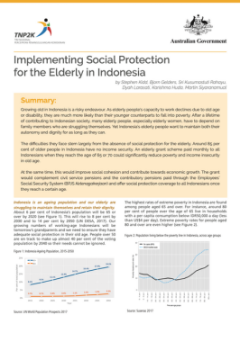
Implementing Social Protection for the Elderly in Indonesia
Growing old in Indonesia is a risky endeavour. As elderly people’s capacity to work declines due to old age or disability, they are much more likely than their younger counterparts to fall into poverty. After a lifetime of contributing to Indonesian society, many elderly people, especially elderly women, have to depend on family members who are struggling themselves. Yet Indonesia’s elderly…
- Edisi
- 1
- ISBN/ISSN
- -
- Deskripsi Fisik
- PDF, 4 Halaman
- Judul Seri
- Policy Brief
- No. Panggil
- 361.1 KID.I

Kemiskinan dan Perekonomian Januari 2013
Indonesia’s economy grew by 6.23% in calendar year 2012, slightly below the government’s target of 6.5%. However, it was sƟll the second fastest‐growing country in the G‐20 aŌer China. The highest rate of growth were recorded in the transportaƟon and communicaƟon sector (9.98%), followed by the trade, hotel and restaurant sector (8.11%). However, the largest contributors to growth w…
- Edisi
- 1
- ISBN/ISSN
- -
- Deskripsi Fisik
- PDF, 2 Halaman
- Judul Seri
- Policy Brief
- No. Panggil
- 362.5 USA.K

Poverty and the Economy February 2013
Indonesia’s economy grew by 6.23% in calendar year 2012, slightly below the government’s target of 6.5%. However, it was sƟll the second fastest‐growing country in the G‐20 aŌer China. The highest rate of growth were recorded in the transportaƟon and communicaƟon sector (9.98%), followed by the trade, hotel and restaurant sector (8.11%). However, the largest contributors to growth w…
- Edisi
- 1
- ISBN/ISSN
- -
- Deskripsi Fisik
- PDF, 2 Halaman
- Judul Seri
- Policy Brief
- No. Panggil
- 362.5 USA.P

Poverty and the Economy October 2012
The world commodity boom was a major factor in Indonesia’s growth from 2005 to 2011. Export earnings increased at a rate of 12% a year. This growth was dominated by commodities. Nearly three-quarters of the increase in commodity exports from 2005 to 2011 was due to increased prices, making Indonesia vulnerable to a downturn in world commodity prices. With slower growth in the world economy, t…
- Edisi
- 1
- ISBN/ISSN
- -
- Deskripsi Fisik
- PDF, 2 Halaman
- Judul Seri
- Policy Brief
- No. Panggil
- 362.5 USA.P

Kemiskinan dan Perekonomian April 2013
Tingkat inflasi untuk Maret 2013 sebesar 0,6%, angka tertinggi untuk bulan Maret selama lima tahun terakhir. Inflasi year-on-year sebesar 5,9%, lebih tinggi dibandingkan 2012 (4%) namun masih lebih rendah dibandingkan Maret 2011 (6,65%). Inflasi bulanan untuk Maret biasanya rendah, bertepatan dengan masa panen. Inflasi tinggi pada Maret 2013 tidak disebabkan kenaikan harga seluruh komoditas aka…
- Edisi
- 1
- ISBN/ISSN
- -
- Deskripsi Fisik
- PDF, 2 Halaman
- Judul Seri
- Policy Brief
- No. Panggil
- 362.5 USA.K
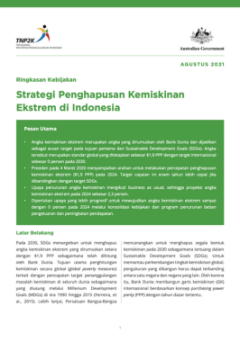
Ringkasan Kebijakan Strategi Penghapusan Kemiskinan Ekstrem di Indonesia
The rural economy makes a significant contribution to the national economy. At present, the impact of the Covid-19 pandemic is felt more in urban areas. Due to the high mobility of seasonal rural workers commuting between their home villages and cities, however, the impact on the rural economy needs to be anticipated promptly.
- Edisi
- 1
- ISBN/ISSN
- -
- Deskripsi Fisik
- PDF, 8 Halaman
- Judul Seri
- Policy Brief
- No. Panggil
- 362.5 ADJ.R
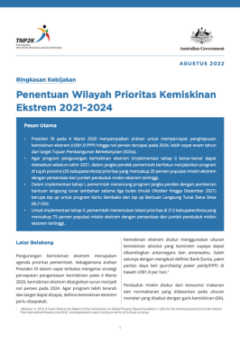
Penentuan Wilayah Prioritas Kemiskinan Ekstrem 2021-2024
The rural economy makes a significant contribution to the national economy. At present, the impact of the Covid-19 pandemic is felt more in urban areas. Due to the high mobility of seasonal rural workers commuting between their home villages and cities, however, the impact on the rural economy needs to be anticipated promptly.
- Edisi
- 1
- ISBN/ISSN
- -
- Deskripsi Fisik
- PDF, 20 Halaman
- Judul Seri
- Policy Brief
- No. Panggil
- 362.5 ADJ.P
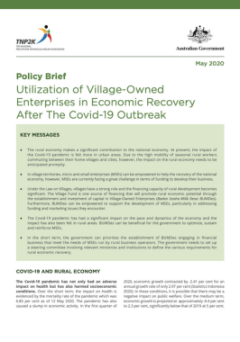
Policy Brief Utilization of Village-Owned Enterprises in Economic Recovery Af…
The rural economy makes a significant contribution to the national economy. At present, the impact of the Covid-19 pandemic is felt more in urban areas. Due to the high mobility of seasonal rural workers commuting between their home villages and cities, however, the impact on the rural economy needs to be anticipated promptly.
- Edisi
- 1
- ISBN/ISSN
- -
- Deskripsi Fisik
- PDF, 10 Halaman
- Judul Seri
- Policy Brief
- No. Panggil
- 362.5 ASM. P
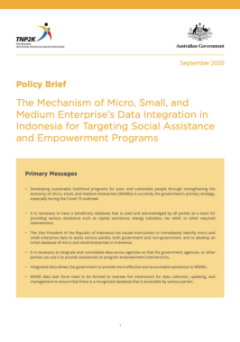
Policy Brief The Mechanism of Micro, Small, and Medium Enterprise’s Data In…
Developing sustainable livelihood programs for poor and vulnerable people through strengthening the economy of micro, small, and medium enterprises (MSMEs) is currently the government's primary strategy, especially during the Covid-19 outbreak.
- Edisi
- 1
- ISBN/ISSN
- -
- Deskripsi Fisik
- PDF, 12 Halaman
- Judul Seri
- Policy Brief
- No. Panggil
- 362.5 HAN.P

Ringkasan Kebijakan Pandemi Covid-19 dan Momentum untuk Memperkuat Sistem Pen…
Terbitnya Peraturan Pemerintah Pengganti UndangUndang Nomor 1 Tahun 2020 dan Peraturan Presiden Nomor 54 Tahun 2020 memberikan instrumen baru untuk meminimalkan dampak pandemi Covid-19 terhadap kondisi sosial dan ekonomi. Pemerintah menambah alokasi jaring pengaman sosial (JPS) tahun 2020 sebesar Rp 110 triliun untuk menanggulangi pandemi tersebut.
- Edisi
- 1
- ISBN/ISSN
- -
- Deskripsi Fisik
- PDF, 8 Halaman
- Judul Seri
- Policy Brief
- No. Panggil
- 361.1 ASM.R

 Karya Umum
Karya Umum  Filsafat
Filsafat  Agama
Agama  Ilmu-ilmu Sosial
Ilmu-ilmu Sosial  Bahasa
Bahasa  Ilmu-ilmu Murni
Ilmu-ilmu Murni  Ilmu-ilmu Terapan
Ilmu-ilmu Terapan  Kesenian, Hiburan, dan Olahraga
Kesenian, Hiburan, dan Olahraga  Kesusastraan
Kesusastraan  Geografi dan Sejarah
Geografi dan Sejarah